Organisational Behaviour Report: A David & Co. Ltd Analysis
VerifiedAdded on 2020/11/12
|18
|4938
|133
Report
AI Summary
This report provides a comprehensive analysis of organisational behaviour within the context of A David & Co. Ltd. It begins by examining the influence of culture, power, and politics on team behaviour and performance, referencing Handy's Topology and French and Raven's forms of power. The report then evaluates content and process theories of motivation, including Vroom's expectancy theory and Maslow's hierarchy of needs, to determine effective strategies for achieving organisational goals. Furthermore, it differentiates between effective and ineffective teams, offering insights into team dynamics and structure. Finally, the report applies organisational behaviour concepts and philosophies to the organisation, providing a holistic view of workplace dynamics. The report emphasizes the interplay of these elements and their impact on organisational success, providing valuable insights into leadership management.
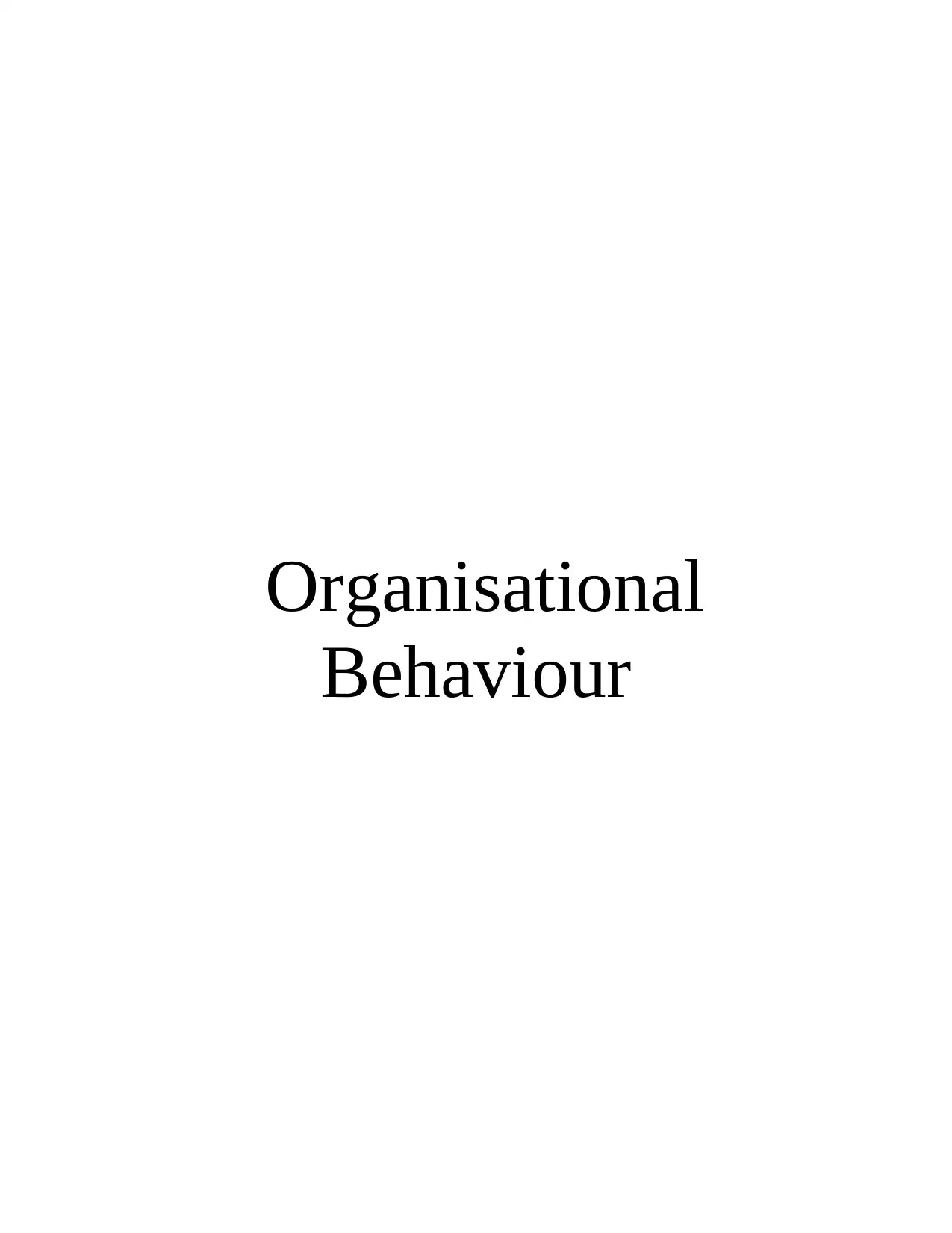
Organisational
Behaviour
Behaviour
Paraphrase This Document
Need a fresh take? Get an instant paraphrase of this document with our AI Paraphraser
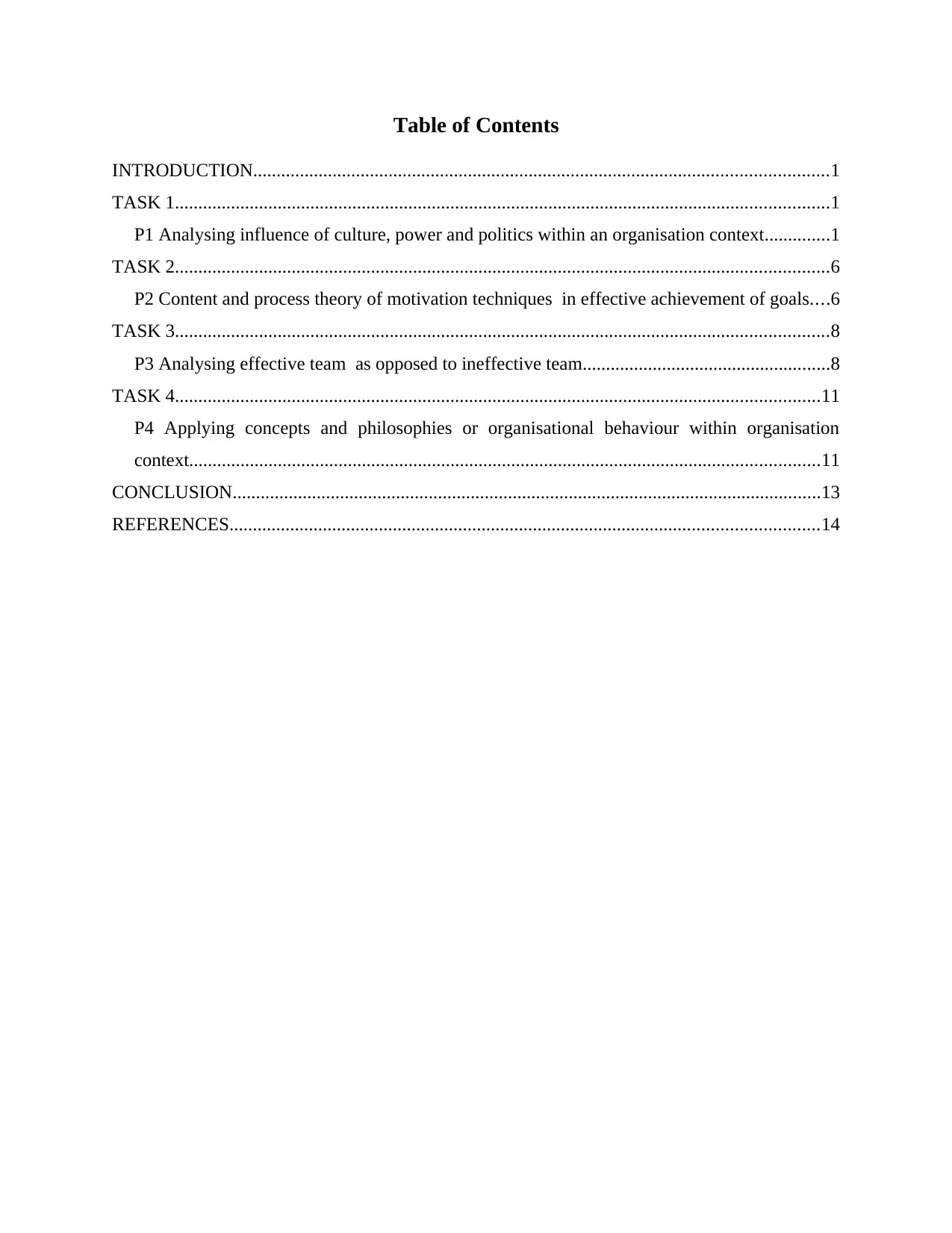
Table of Contents
INTRODUCTION...........................................................................................................................1
TASK 1............................................................................................................................................1
P1 Analysing influence of culture, power and politics within an organisation context..............1
TASK 2............................................................................................................................................6
P2 Content and process theory of motivation techniques in effective achievement of goals....6
TASK 3............................................................................................................................................8
P3 Analysing effective team as opposed to ineffective team.....................................................8
TASK 4..........................................................................................................................................11
P4 Applying concepts and philosophies or organisational behaviour within organisation
context.......................................................................................................................................11
CONCLUSION..............................................................................................................................13
REFERENCES..............................................................................................................................14
INTRODUCTION...........................................................................................................................1
TASK 1............................................................................................................................................1
P1 Analysing influence of culture, power and politics within an organisation context..............1
TASK 2............................................................................................................................................6
P2 Content and process theory of motivation techniques in effective achievement of goals....6
TASK 3............................................................................................................................................8
P3 Analysing effective team as opposed to ineffective team.....................................................8
TASK 4..........................................................................................................................................11
P4 Applying concepts and philosophies or organisational behaviour within organisation
context.......................................................................................................................................11
CONCLUSION..............................................................................................................................13
REFERENCES..............................................................................................................................14
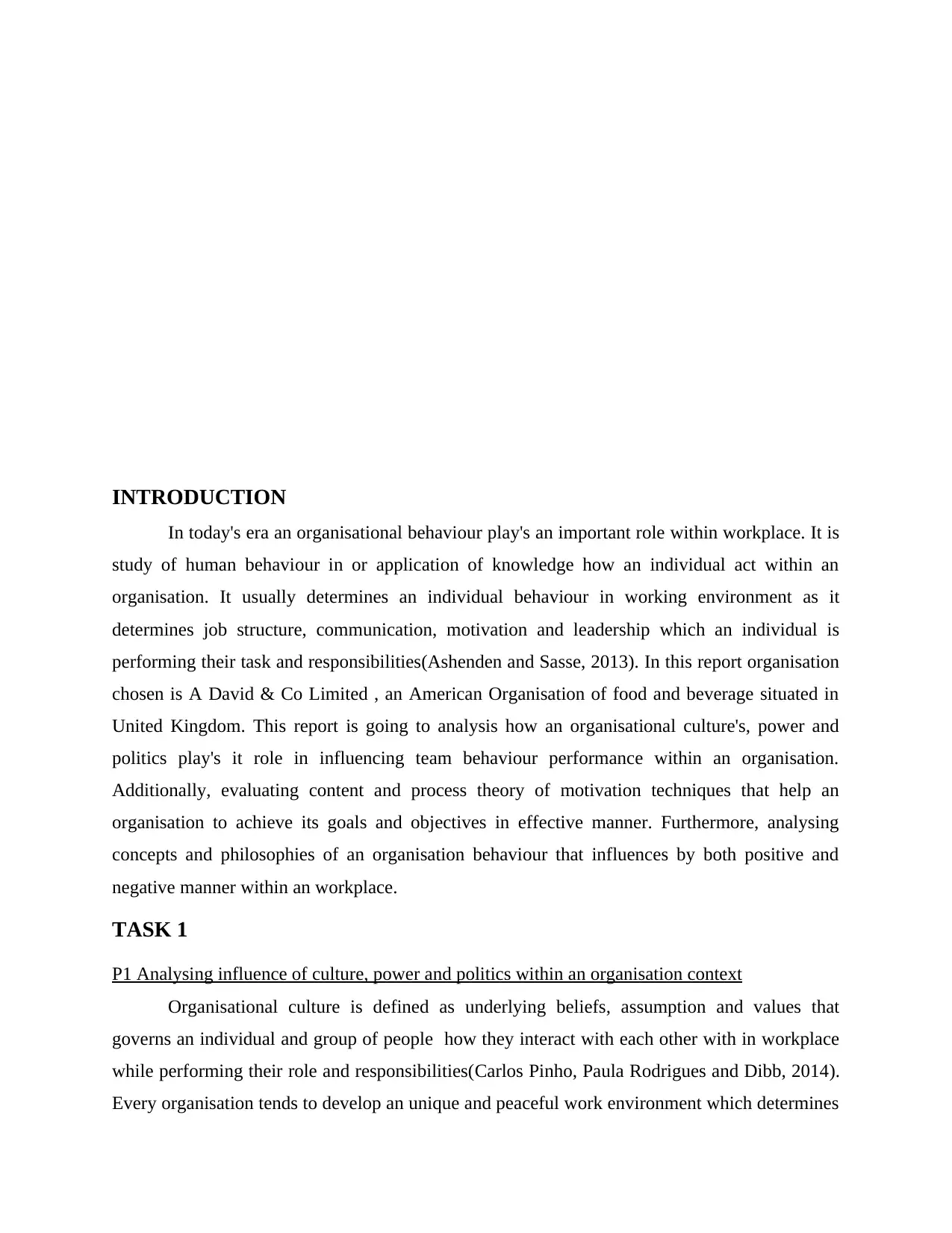
INTRODUCTION
In today's era an organisational behaviour play's an important role within workplace. It is
study of human behaviour in or application of knowledge how an individual act within an
organisation. It usually determines an individual behaviour in working environment as it
determines job structure, communication, motivation and leadership which an individual is
performing their task and responsibilities(Ashenden and Sasse, 2013). In this report organisation
chosen is A David & Co Limited , an American Organisation of food and beverage situated in
United Kingdom. This report is going to analysis how an organisational culture's, power and
politics play's it role in influencing team behaviour performance within an organisation.
Additionally, evaluating content and process theory of motivation techniques that help an
organisation to achieve its goals and objectives in effective manner. Furthermore, analysing
concepts and philosophies of an organisation behaviour that influences by both positive and
negative manner within an workplace.
TASK 1
P1 Analysing influence of culture, power and politics within an organisation context
Organisational culture is defined as underlying beliefs, assumption and values that
governs an individual and group of people how they interact with each other with in workplace
while performing their role and responsibilities(Carlos Pinho, Paula Rodrigues and Dibb, 2014).
Every organisation tends to develop an unique and peaceful work environment which determines
In today's era an organisational behaviour play's an important role within workplace. It is
study of human behaviour in or application of knowledge how an individual act within an
organisation. It usually determines an individual behaviour in working environment as it
determines job structure, communication, motivation and leadership which an individual is
performing their task and responsibilities(Ashenden and Sasse, 2013). In this report organisation
chosen is A David & Co Limited , an American Organisation of food and beverage situated in
United Kingdom. This report is going to analysis how an organisational culture's, power and
politics play's it role in influencing team behaviour performance within an organisation.
Additionally, evaluating content and process theory of motivation techniques that help an
organisation to achieve its goals and objectives in effective manner. Furthermore, analysing
concepts and philosophies of an organisation behaviour that influences by both positive and
negative manner within an workplace.
TASK 1
P1 Analysing influence of culture, power and politics within an organisation context
Organisational culture is defined as underlying beliefs, assumption and values that
governs an individual and group of people how they interact with each other with in workplace
while performing their role and responsibilities(Carlos Pinho, Paula Rodrigues and Dibb, 2014).
Every organisation tends to develop an unique and peaceful work environment which determines
⊘ This is a preview!⊘
Do you want full access?
Subscribe today to unlock all pages.

Trusted by 1+ million students worldwide
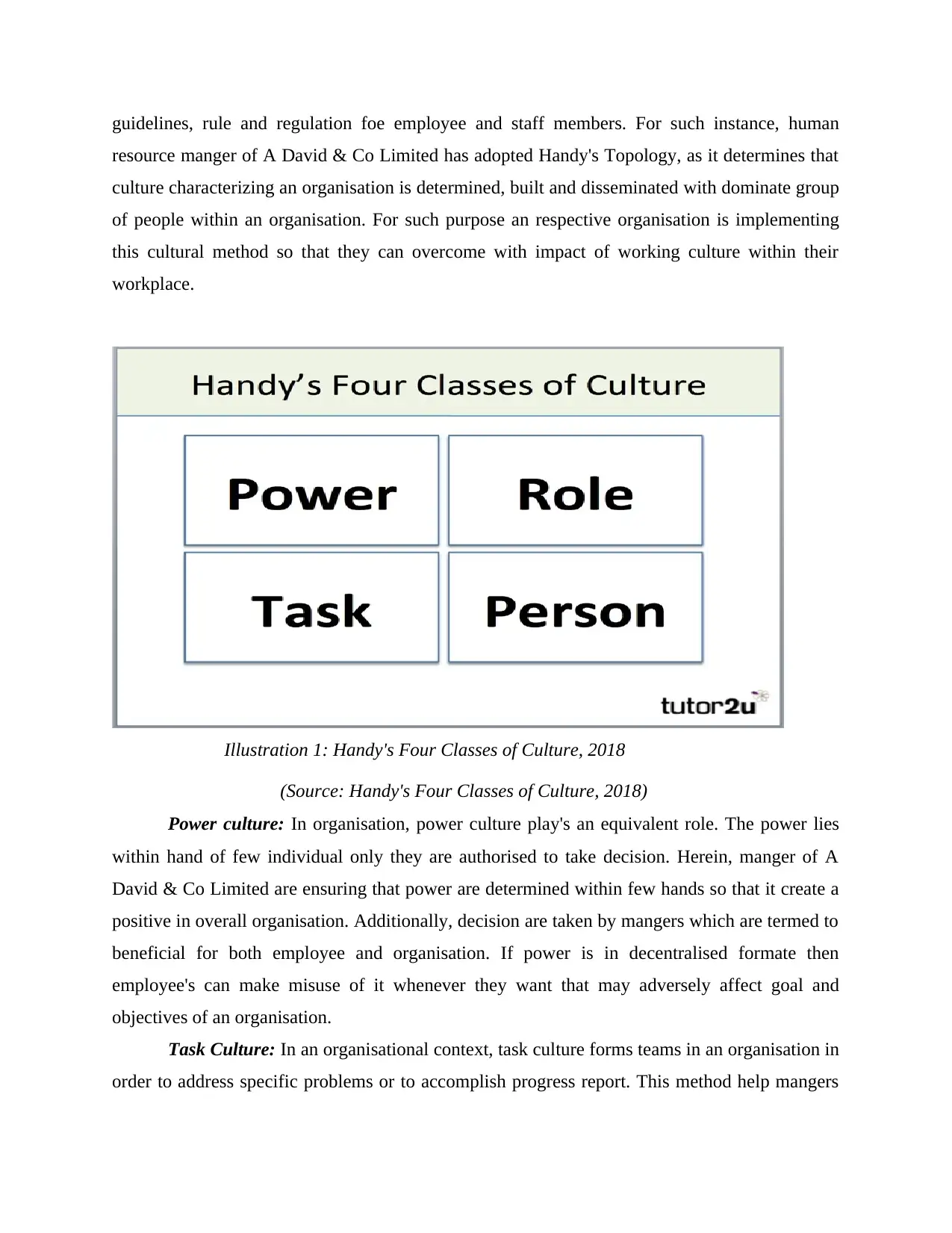
guidelines, rule and regulation foe employee and staff members. For such instance, human
resource manger of A David & Co Limited has adopted Handy's Topology, as it determines that
culture characterizing an organisation is determined, built and disseminated with dominate group
of people within an organisation. For such purpose an respective organisation is implementing
this cultural method so that they can overcome with impact of working culture within their
workplace.
Power culture: In organisation, power culture play's an equivalent role. The power lies
within hand of few individual only they are authorised to take decision. Herein, manger of A
David & Co Limited are ensuring that power are determined within few hands so that it create a
positive in overall organisation. Additionally, decision are taken by mangers which are termed to
beneficial for both employee and organisation. If power is in decentralised formate then
employee's can make misuse of it whenever they want that may adversely affect goal and
objectives of an organisation.
Task Culture: In an organisational context, task culture forms teams in an organisation in
order to address specific problems or to accomplish progress report. This method help mangers
Illustration 1: Handy's Four Classes of Culture, 2018
(Source: Handy's Four Classes of Culture, 2018)
resource manger of A David & Co Limited has adopted Handy's Topology, as it determines that
culture characterizing an organisation is determined, built and disseminated with dominate group
of people within an organisation. For such purpose an respective organisation is implementing
this cultural method so that they can overcome with impact of working culture within their
workplace.
Power culture: In organisation, power culture play's an equivalent role. The power lies
within hand of few individual only they are authorised to take decision. Herein, manger of A
David & Co Limited are ensuring that power are determined within few hands so that it create a
positive in overall organisation. Additionally, decision are taken by mangers which are termed to
beneficial for both employee and organisation. If power is in decentralised formate then
employee's can make misuse of it whenever they want that may adversely affect goal and
objectives of an organisation.
Task Culture: In an organisational context, task culture forms teams in an organisation in
order to address specific problems or to accomplish progress report. This method help mangers
Illustration 1: Handy's Four Classes of Culture, 2018
(Source: Handy's Four Classes of Culture, 2018)
Paraphrase This Document
Need a fresh take? Get an instant paraphrase of this document with our AI Paraphraser
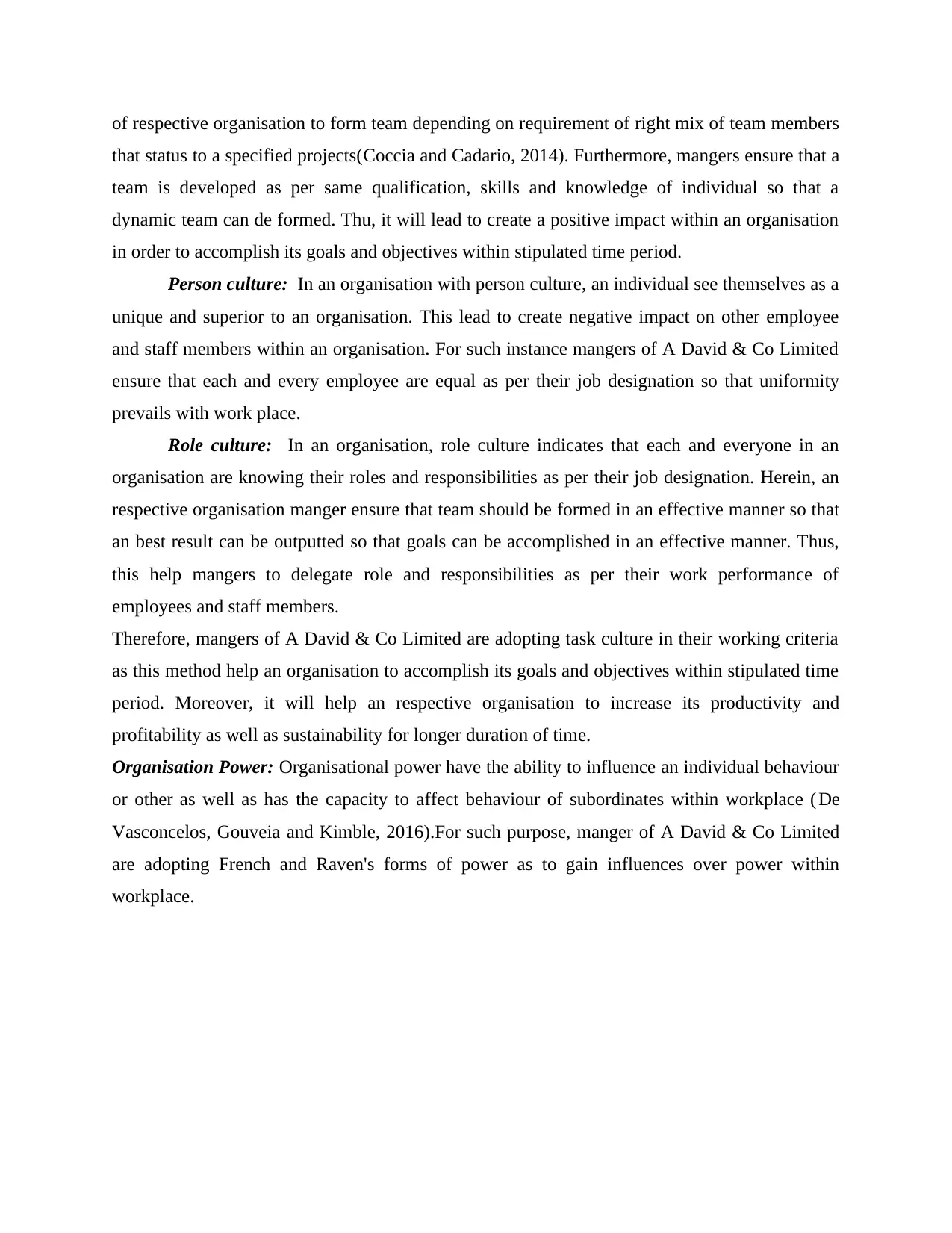
of respective organisation to form team depending on requirement of right mix of team members
that status to a specified projects(Coccia and Cadario, 2014). Furthermore, mangers ensure that a
team is developed as per same qualification, skills and knowledge of individual so that a
dynamic team can de formed. Thu, it will lead to create a positive impact within an organisation
in order to accomplish its goals and objectives within stipulated time period.
Person culture: In an organisation with person culture, an individual see themselves as a
unique and superior to an organisation. This lead to create negative impact on other employee
and staff members within an organisation. For such instance mangers of A David & Co Limited
ensure that each and every employee are equal as per their job designation so that uniformity
prevails with work place.
Role culture: In an organisation, role culture indicates that each and everyone in an
organisation are knowing their roles and responsibilities as per their job designation. Herein, an
respective organisation manger ensure that team should be formed in an effective manner so that
an best result can be outputted so that goals can be accomplished in an effective manner. Thus,
this help mangers to delegate role and responsibilities as per their work performance of
employees and staff members.
Therefore, mangers of A David & Co Limited are adopting task culture in their working criteria
as this method help an organisation to accomplish its goals and objectives within stipulated time
period. Moreover, it will help an respective organisation to increase its productivity and
profitability as well as sustainability for longer duration of time.
Organisation Power: Organisational power have the ability to influence an individual behaviour
or other as well as has the capacity to affect behaviour of subordinates within workplace (De
Vasconcelos, Gouveia and Kimble, 2016).For such purpose, manger of A David & Co Limited
are adopting French and Raven's forms of power as to gain influences over power within
workplace.
that status to a specified projects(Coccia and Cadario, 2014). Furthermore, mangers ensure that a
team is developed as per same qualification, skills and knowledge of individual so that a
dynamic team can de formed. Thu, it will lead to create a positive impact within an organisation
in order to accomplish its goals and objectives within stipulated time period.
Person culture: In an organisation with person culture, an individual see themselves as a
unique and superior to an organisation. This lead to create negative impact on other employee
and staff members within an organisation. For such instance mangers of A David & Co Limited
ensure that each and every employee are equal as per their job designation so that uniformity
prevails with work place.
Role culture: In an organisation, role culture indicates that each and everyone in an
organisation are knowing their roles and responsibilities as per their job designation. Herein, an
respective organisation manger ensure that team should be formed in an effective manner so that
an best result can be outputted so that goals can be accomplished in an effective manner. Thus,
this help mangers to delegate role and responsibilities as per their work performance of
employees and staff members.
Therefore, mangers of A David & Co Limited are adopting task culture in their working criteria
as this method help an organisation to accomplish its goals and objectives within stipulated time
period. Moreover, it will help an respective organisation to increase its productivity and
profitability as well as sustainability for longer duration of time.
Organisation Power: Organisational power have the ability to influence an individual behaviour
or other as well as has the capacity to affect behaviour of subordinates within workplace (De
Vasconcelos, Gouveia and Kimble, 2016).For such purpose, manger of A David & Co Limited
are adopting French and Raven's forms of power as to gain influences over power within
workplace.
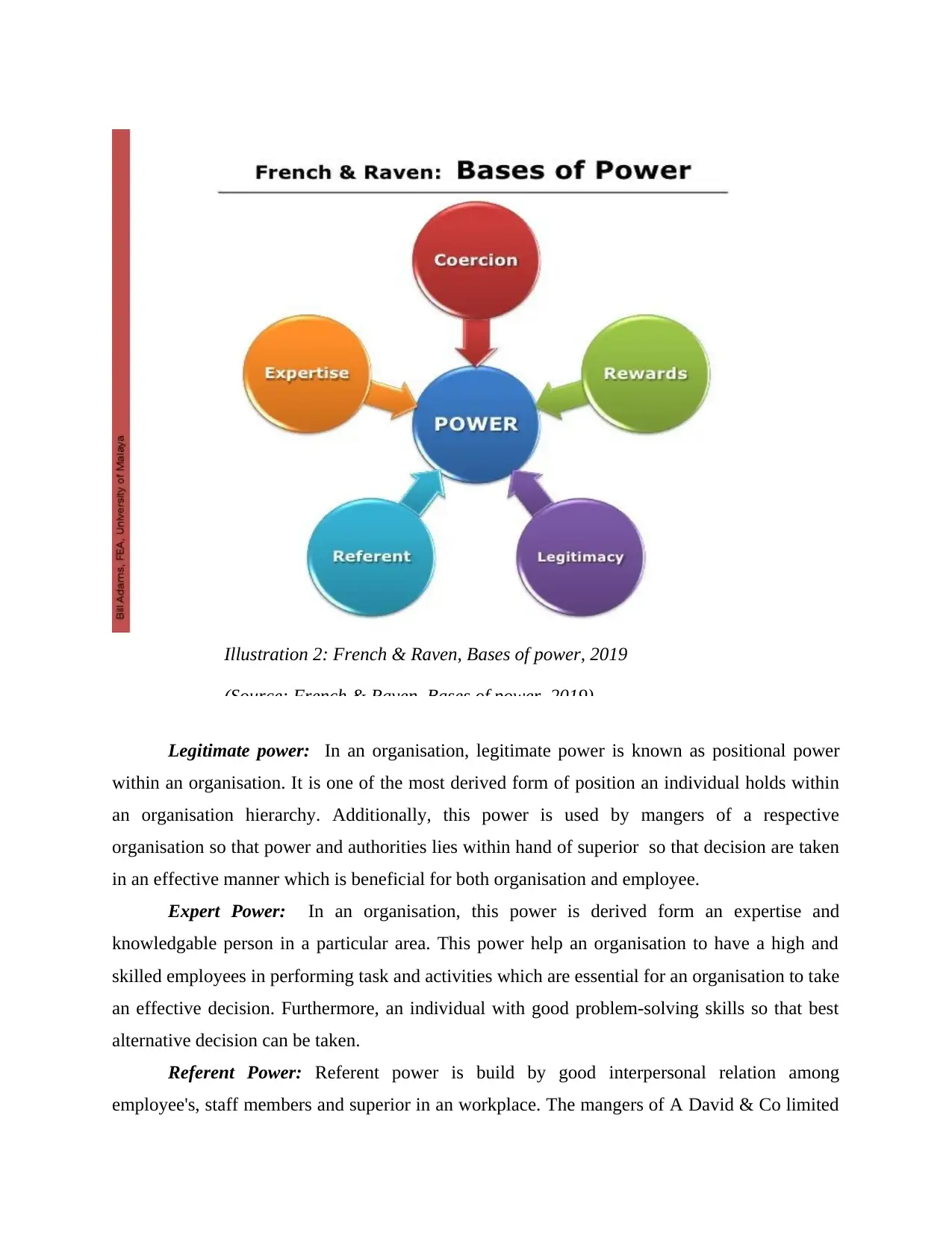
Legitimate power: In an organisation, legitimate power is known as positional power
within an organisation. It is one of the most derived form of position an individual holds within
an organisation hierarchy. Additionally, this power is used by mangers of a respective
organisation so that power and authorities lies within hand of superior so that decision are taken
in an effective manner which is beneficial for both organisation and employee.
Expert Power: In an organisation, this power is derived form an expertise and
knowledgable person in a particular area. This power help an organisation to have a high and
skilled employees in performing task and activities which are essential for an organisation to take
an effective decision. Furthermore, an individual with good problem-solving skills so that best
alternative decision can be taken.
Referent Power: Referent power is build by good interpersonal relation among
employee's, staff members and superior in an workplace. The mangers of A David & Co limited
Illustration 2: French & Raven, Bases of power, 2019
(Source: French & Raven, Bases of power, 2019)
within an organisation. It is one of the most derived form of position an individual holds within
an organisation hierarchy. Additionally, this power is used by mangers of a respective
organisation so that power and authorities lies within hand of superior so that decision are taken
in an effective manner which is beneficial for both organisation and employee.
Expert Power: In an organisation, this power is derived form an expertise and
knowledgable person in a particular area. This power help an organisation to have a high and
skilled employees in performing task and activities which are essential for an organisation to take
an effective decision. Furthermore, an individual with good problem-solving skills so that best
alternative decision can be taken.
Referent Power: Referent power is build by good interpersonal relation among
employee's, staff members and superior in an workplace. The mangers of A David & Co limited
Illustration 2: French & Raven, Bases of power, 2019
(Source: French & Raven, Bases of power, 2019)
⊘ This is a preview!⊘
Do you want full access?
Subscribe today to unlock all pages.

Trusted by 1+ million students worldwide
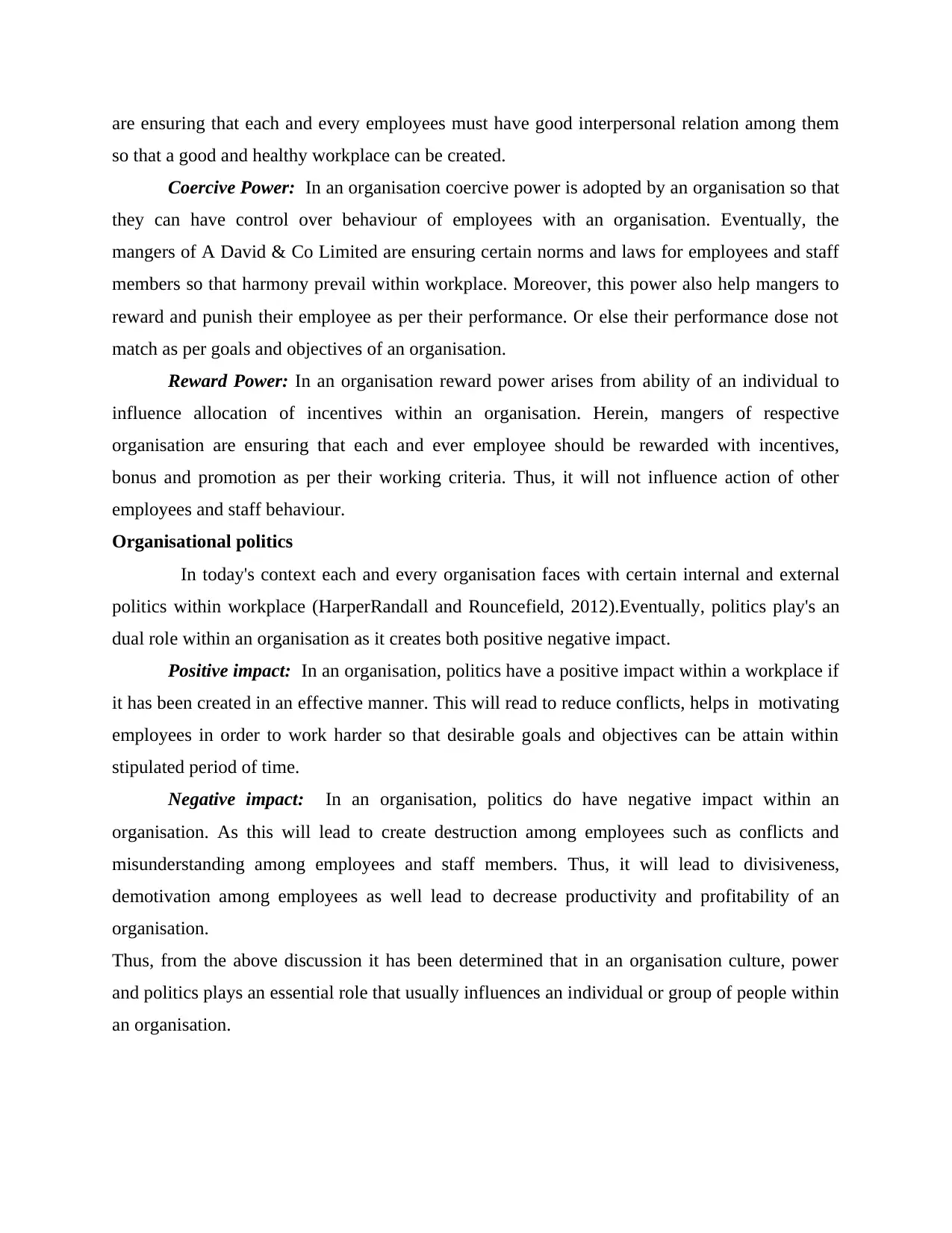
are ensuring that each and every employees must have good interpersonal relation among them
so that a good and healthy workplace can be created.
Coercive Power: In an organisation coercive power is adopted by an organisation so that
they can have control over behaviour of employees with an organisation. Eventually, the
mangers of A David & Co Limited are ensuring certain norms and laws for employees and staff
members so that harmony prevail within workplace. Moreover, this power also help mangers to
reward and punish their employee as per their performance. Or else their performance dose not
match as per goals and objectives of an organisation.
Reward Power: In an organisation reward power arises from ability of an individual to
influence allocation of incentives within an organisation. Herein, mangers of respective
organisation are ensuring that each and ever employee should be rewarded with incentives,
bonus and promotion as per their working criteria. Thus, it will not influence action of other
employees and staff behaviour.
Organisational politics
In today's context each and every organisation faces with certain internal and external
politics within workplace (HarperRandall and Rouncefield, 2012).Eventually, politics play's an
dual role within an organisation as it creates both positive negative impact.
Positive impact: In an organisation, politics have a positive impact within a workplace if
it has been created in an effective manner. This will read to reduce conflicts, helps in motivating
employees in order to work harder so that desirable goals and objectives can be attain within
stipulated period of time.
Negative impact: In an organisation, politics do have negative impact within an
organisation. As this will lead to create destruction among employees such as conflicts and
misunderstanding among employees and staff members. Thus, it will lead to divisiveness,
demotivation among employees as well lead to decrease productivity and profitability of an
organisation.
Thus, from the above discussion it has been determined that in an organisation culture, power
and politics plays an essential role that usually influences an individual or group of people within
an organisation.
so that a good and healthy workplace can be created.
Coercive Power: In an organisation coercive power is adopted by an organisation so that
they can have control over behaviour of employees with an organisation. Eventually, the
mangers of A David & Co Limited are ensuring certain norms and laws for employees and staff
members so that harmony prevail within workplace. Moreover, this power also help mangers to
reward and punish their employee as per their performance. Or else their performance dose not
match as per goals and objectives of an organisation.
Reward Power: In an organisation reward power arises from ability of an individual to
influence allocation of incentives within an organisation. Herein, mangers of respective
organisation are ensuring that each and ever employee should be rewarded with incentives,
bonus and promotion as per their working criteria. Thus, it will not influence action of other
employees and staff behaviour.
Organisational politics
In today's context each and every organisation faces with certain internal and external
politics within workplace (HarperRandall and Rouncefield, 2012).Eventually, politics play's an
dual role within an organisation as it creates both positive negative impact.
Positive impact: In an organisation, politics have a positive impact within a workplace if
it has been created in an effective manner. This will read to reduce conflicts, helps in motivating
employees in order to work harder so that desirable goals and objectives can be attain within
stipulated period of time.
Negative impact: In an organisation, politics do have negative impact within an
organisation. As this will lead to create destruction among employees such as conflicts and
misunderstanding among employees and staff members. Thus, it will lead to divisiveness,
demotivation among employees as well lead to decrease productivity and profitability of an
organisation.
Thus, from the above discussion it has been determined that in an organisation culture, power
and politics plays an essential role that usually influences an individual or group of people within
an organisation.
Paraphrase This Document
Need a fresh take? Get an instant paraphrase of this document with our AI Paraphraser
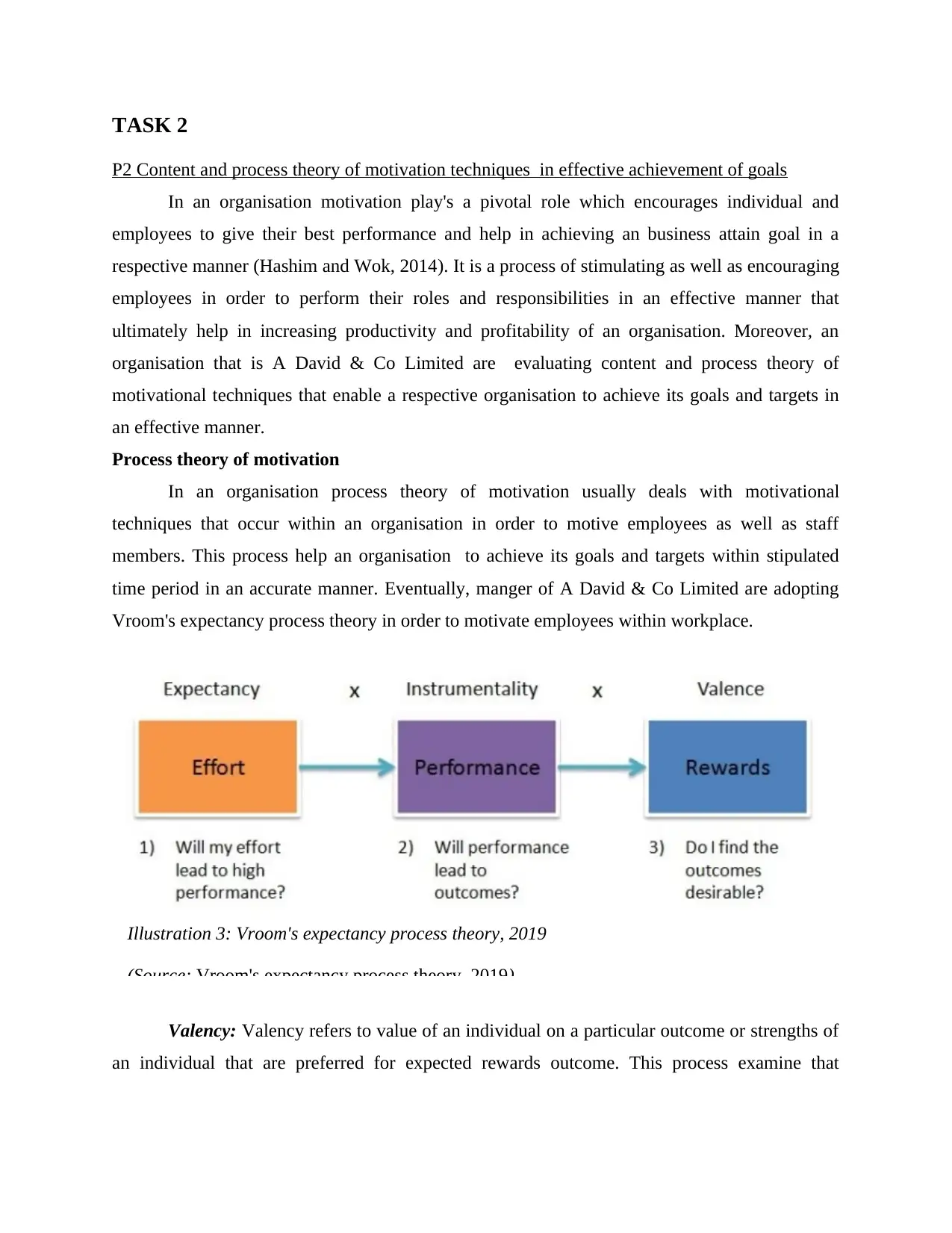
TASK 2
P2 Content and process theory of motivation techniques in effective achievement of goals
In an organisation motivation play's a pivotal role which encourages individual and
employees to give their best performance and help in achieving an business attain goal in a
respective manner (Hashim and Wok, 2014). It is a process of stimulating as well as encouraging
employees in order to perform their roles and responsibilities in an effective manner that
ultimately help in increasing productivity and profitability of an organisation. Moreover, an
organisation that is A David & Co Limited are evaluating content and process theory of
motivational techniques that enable a respective organisation to achieve its goals and targets in
an effective manner.
Process theory of motivation
In an organisation process theory of motivation usually deals with motivational
techniques that occur within an organisation in order to motive employees as well as staff
members. This process help an organisation to achieve its goals and targets within stipulated
time period in an accurate manner. Eventually, manger of A David & Co Limited are adopting
Vroom's expectancy process theory in order to motivate employees within workplace.
Valency: Valency refers to value of an individual on a particular outcome or strengths of
an individual that are preferred for expected rewards outcome. This process examine that
Illustration 3: Vroom's expectancy process theory, 2019
(Source: Vroom's expectancy process theory, 2019)
P2 Content and process theory of motivation techniques in effective achievement of goals
In an organisation motivation play's a pivotal role which encourages individual and
employees to give their best performance and help in achieving an business attain goal in a
respective manner (Hashim and Wok, 2014). It is a process of stimulating as well as encouraging
employees in order to perform their roles and responsibilities in an effective manner that
ultimately help in increasing productivity and profitability of an organisation. Moreover, an
organisation that is A David & Co Limited are evaluating content and process theory of
motivational techniques that enable a respective organisation to achieve its goals and targets in
an effective manner.
Process theory of motivation
In an organisation process theory of motivation usually deals with motivational
techniques that occur within an organisation in order to motive employees as well as staff
members. This process help an organisation to achieve its goals and targets within stipulated
time period in an accurate manner. Eventually, manger of A David & Co Limited are adopting
Vroom's expectancy process theory in order to motivate employees within workplace.
Valency: Valency refers to value of an individual on a particular outcome or strengths of
an individual that are preferred for expected rewards outcome. This process examine that
Illustration 3: Vroom's expectancy process theory, 2019
(Source: Vroom's expectancy process theory, 2019)
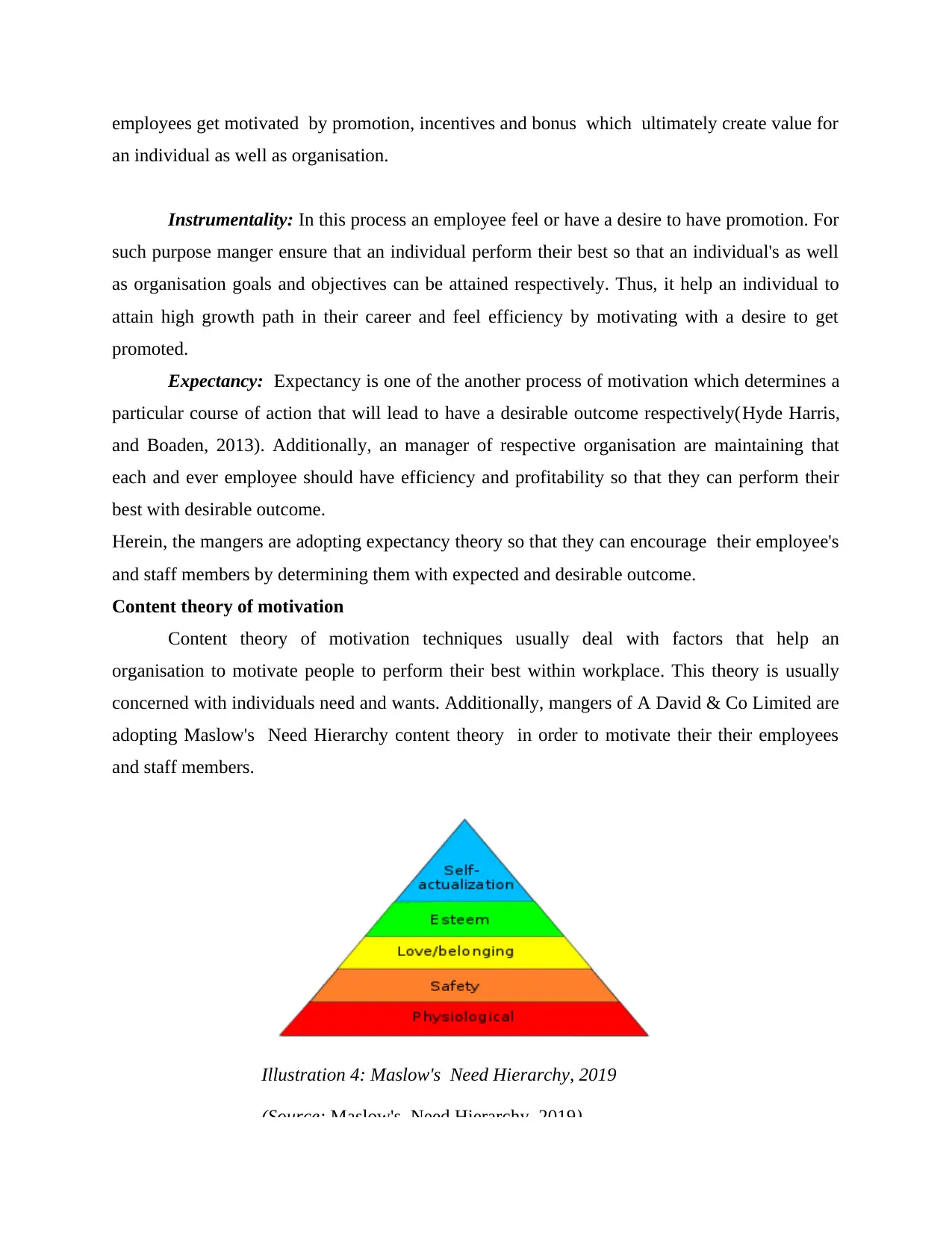
employees get motivated by promotion, incentives and bonus which ultimately create value for
an individual as well as organisation.
Instrumentality: In this process an employee feel or have a desire to have promotion. For
such purpose manger ensure that an individual perform their best so that an individual's as well
as organisation goals and objectives can be attained respectively. Thus, it help an individual to
attain high growth path in their career and feel efficiency by motivating with a desire to get
promoted.
Expectancy: Expectancy is one of the another process of motivation which determines a
particular course of action that will lead to have a desirable outcome respectively(Hyde Harris,
and Boaden, 2013). Additionally, an manager of respective organisation are maintaining that
each and ever employee should have efficiency and profitability so that they can perform their
best with desirable outcome.
Herein, the mangers are adopting expectancy theory so that they can encourage their employee's
and staff members by determining them with expected and desirable outcome.
Content theory of motivation
Content theory of motivation techniques usually deal with factors that help an
organisation to motivate people to perform their best within workplace. This theory is usually
concerned with individuals need and wants. Additionally, mangers of A David & Co Limited are
adopting Maslow's Need Hierarchy content theory in order to motivate their their employees
and staff members.
Illustration 4: Maslow's Need Hierarchy, 2019
(Source: Maslow's Need Hierarchy, 2019)
an individual as well as organisation.
Instrumentality: In this process an employee feel or have a desire to have promotion. For
such purpose manger ensure that an individual perform their best so that an individual's as well
as organisation goals and objectives can be attained respectively. Thus, it help an individual to
attain high growth path in their career and feel efficiency by motivating with a desire to get
promoted.
Expectancy: Expectancy is one of the another process of motivation which determines a
particular course of action that will lead to have a desirable outcome respectively(Hyde Harris,
and Boaden, 2013). Additionally, an manager of respective organisation are maintaining that
each and ever employee should have efficiency and profitability so that they can perform their
best with desirable outcome.
Herein, the mangers are adopting expectancy theory so that they can encourage their employee's
and staff members by determining them with expected and desirable outcome.
Content theory of motivation
Content theory of motivation techniques usually deal with factors that help an
organisation to motivate people to perform their best within workplace. This theory is usually
concerned with individuals need and wants. Additionally, mangers of A David & Co Limited are
adopting Maslow's Need Hierarchy content theory in order to motivate their their employees
and staff members.
Illustration 4: Maslow's Need Hierarchy, 2019
(Source: Maslow's Need Hierarchy, 2019)
⊘ This is a preview!⊘
Do you want full access?
Subscribe today to unlock all pages.

Trusted by 1+ million students worldwide
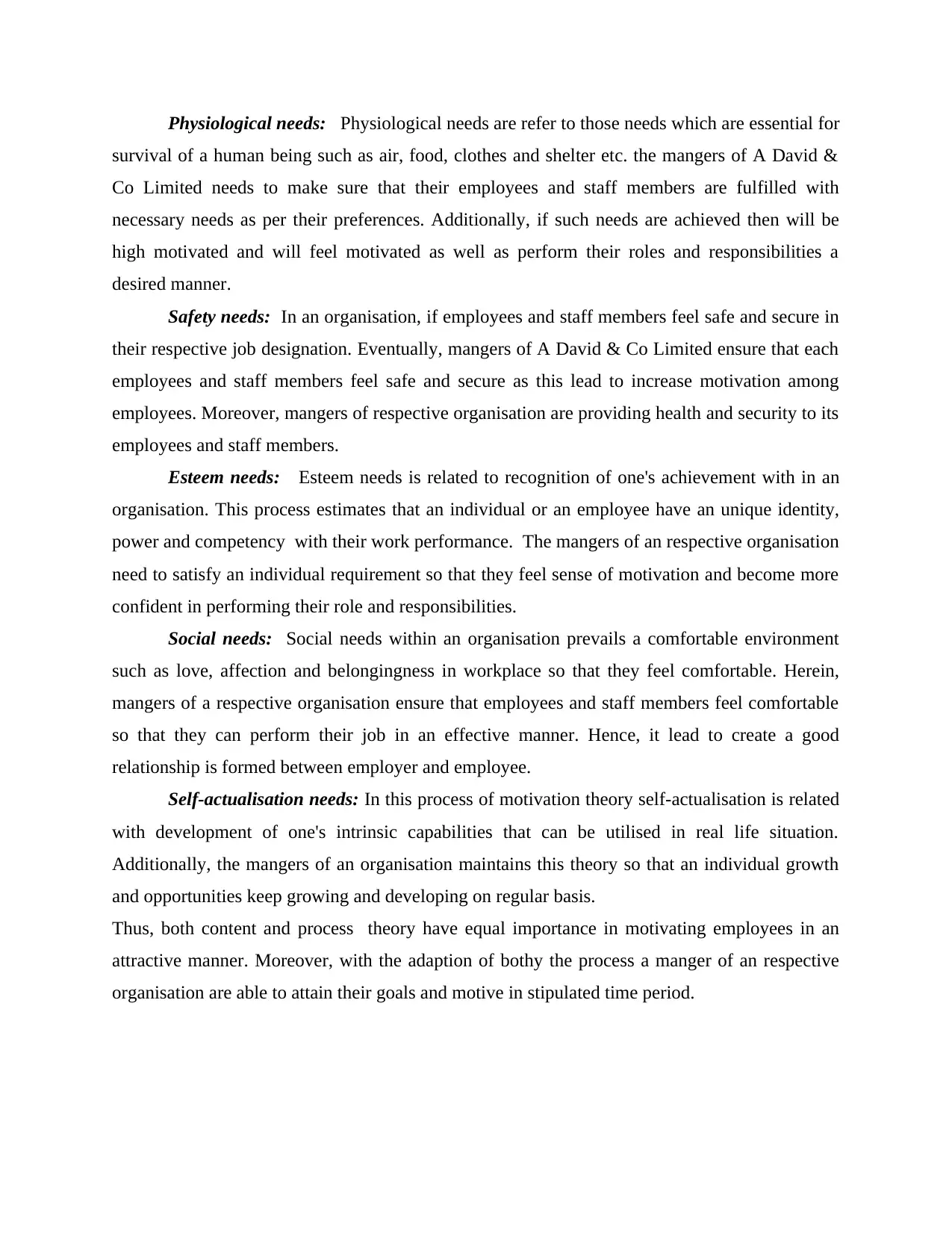
Physiological needs: Physiological needs are refer to those needs which are essential for
survival of a human being such as air, food, clothes and shelter etc. the mangers of A David &
Co Limited needs to make sure that their employees and staff members are fulfilled with
necessary needs as per their preferences. Additionally, if such needs are achieved then will be
high motivated and will feel motivated as well as perform their roles and responsibilities a
desired manner.
Safety needs: In an organisation, if employees and staff members feel safe and secure in
their respective job designation. Eventually, mangers of A David & Co Limited ensure that each
employees and staff members feel safe and secure as this lead to increase motivation among
employees. Moreover, mangers of respective organisation are providing health and security to its
employees and staff members.
Esteem needs: Esteem needs is related to recognition of one's achievement with in an
organisation. This process estimates that an individual or an employee have an unique identity,
power and competency with their work performance. The mangers of an respective organisation
need to satisfy an individual requirement so that they feel sense of motivation and become more
confident in performing their role and responsibilities.
Social needs: Social needs within an organisation prevails a comfortable environment
such as love, affection and belongingness in workplace so that they feel comfortable. Herein,
mangers of a respective organisation ensure that employees and staff members feel comfortable
so that they can perform their job in an effective manner. Hence, it lead to create a good
relationship is formed between employer and employee.
Self-actualisation needs: In this process of motivation theory self-actualisation is related
with development of one's intrinsic capabilities that can be utilised in real life situation.
Additionally, the mangers of an organisation maintains this theory so that an individual growth
and opportunities keep growing and developing on regular basis.
Thus, both content and process theory have equal importance in motivating employees in an
attractive manner. Moreover, with the adaption of bothy the process a manger of an respective
organisation are able to attain their goals and motive in stipulated time period.
survival of a human being such as air, food, clothes and shelter etc. the mangers of A David &
Co Limited needs to make sure that their employees and staff members are fulfilled with
necessary needs as per their preferences. Additionally, if such needs are achieved then will be
high motivated and will feel motivated as well as perform their roles and responsibilities a
desired manner.
Safety needs: In an organisation, if employees and staff members feel safe and secure in
their respective job designation. Eventually, mangers of A David & Co Limited ensure that each
employees and staff members feel safe and secure as this lead to increase motivation among
employees. Moreover, mangers of respective organisation are providing health and security to its
employees and staff members.
Esteem needs: Esteem needs is related to recognition of one's achievement with in an
organisation. This process estimates that an individual or an employee have an unique identity,
power and competency with their work performance. The mangers of an respective organisation
need to satisfy an individual requirement so that they feel sense of motivation and become more
confident in performing their role and responsibilities.
Social needs: Social needs within an organisation prevails a comfortable environment
such as love, affection and belongingness in workplace so that they feel comfortable. Herein,
mangers of a respective organisation ensure that employees and staff members feel comfortable
so that they can perform their job in an effective manner. Hence, it lead to create a good
relationship is formed between employer and employee.
Self-actualisation needs: In this process of motivation theory self-actualisation is related
with development of one's intrinsic capabilities that can be utilised in real life situation.
Additionally, the mangers of an organisation maintains this theory so that an individual growth
and opportunities keep growing and developing on regular basis.
Thus, both content and process theory have equal importance in motivating employees in an
attractive manner. Moreover, with the adaption of bothy the process a manger of an respective
organisation are able to attain their goals and motive in stipulated time period.
Paraphrase This Document
Need a fresh take? Get an instant paraphrase of this document with our AI Paraphraser
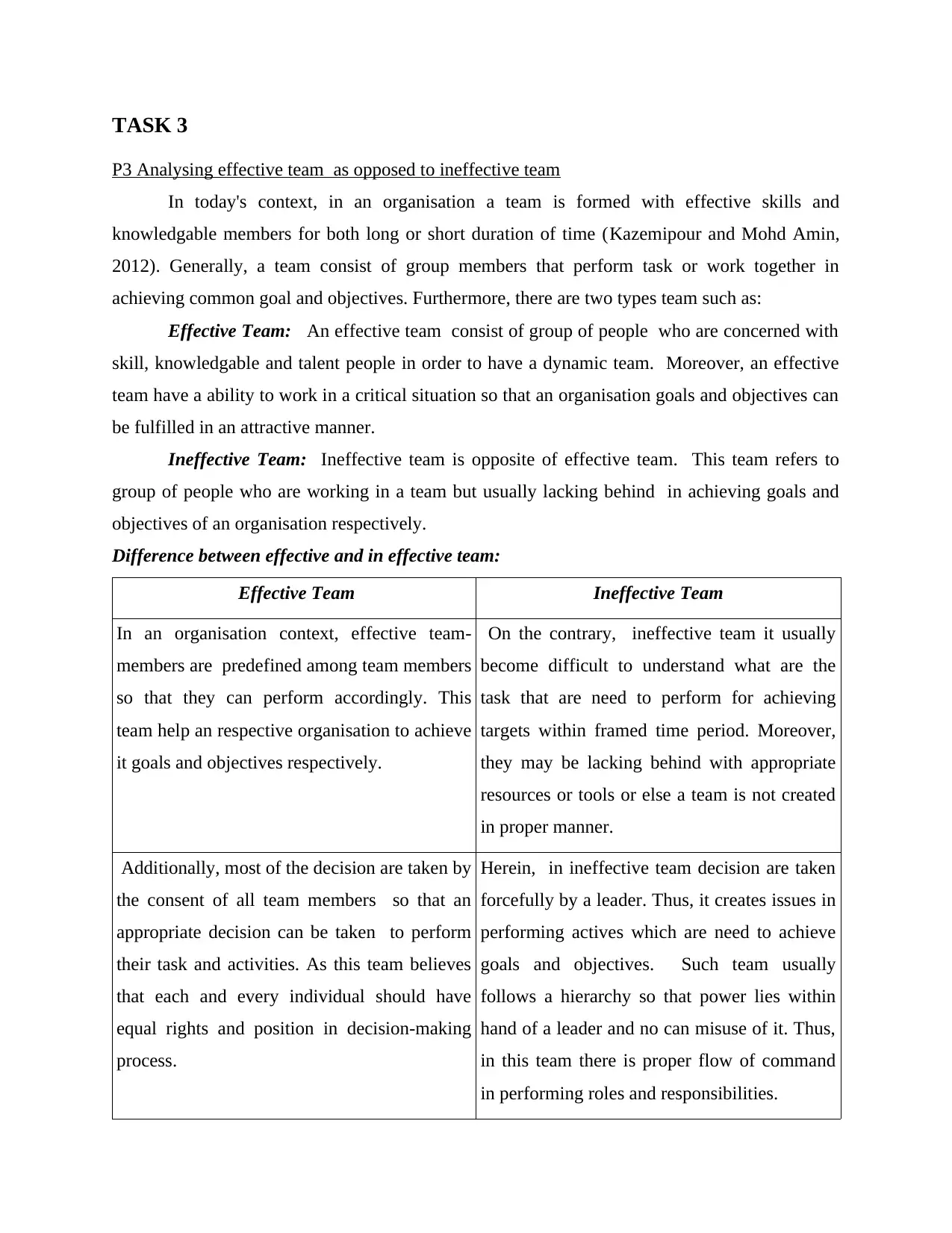
TASK 3
P3 Analysing effective team as opposed to ineffective team
In today's context, in an organisation a team is formed with effective skills and
knowledgable members for both long or short duration of time (Kazemipour and Mohd Amin,
2012). Generally, a team consist of group members that perform task or work together in
achieving common goal and objectives. Furthermore, there are two types team such as:
Effective Team: An effective team consist of group of people who are concerned with
skill, knowledgable and talent people in order to have a dynamic team. Moreover, an effective
team have a ability to work in a critical situation so that an organisation goals and objectives can
be fulfilled in an attractive manner.
Ineffective Team: Ineffective team is opposite of effective team. This team refers to
group of people who are working in a team but usually lacking behind in achieving goals and
objectives of an organisation respectively.
Difference between effective and in effective team:
Effective Team Ineffective Team
In an organisation context, effective team-
members are predefined among team members
so that they can perform accordingly. This
team help an respective organisation to achieve
it goals and objectives respectively.
On the contrary, ineffective team it usually
become difficult to understand what are the
task that are need to perform for achieving
targets within framed time period. Moreover,
they may be lacking behind with appropriate
resources or tools or else a team is not created
in proper manner.
Additionally, most of the decision are taken by
the consent of all team members so that an
appropriate decision can be taken to perform
their task and activities. As this team believes
that each and every individual should have
equal rights and position in decision-making
process.
Herein, in ineffective team decision are taken
forcefully by a leader. Thus, it creates issues in
performing actives which are need to achieve
goals and objectives. Such team usually
follows a hierarchy so that power lies within
hand of a leader and no can misuse of it. Thus,
in this team there is proper flow of command
in performing roles and responsibilities.
P3 Analysing effective team as opposed to ineffective team
In today's context, in an organisation a team is formed with effective skills and
knowledgable members for both long or short duration of time (Kazemipour and Mohd Amin,
2012). Generally, a team consist of group members that perform task or work together in
achieving common goal and objectives. Furthermore, there are two types team such as:
Effective Team: An effective team consist of group of people who are concerned with
skill, knowledgable and talent people in order to have a dynamic team. Moreover, an effective
team have a ability to work in a critical situation so that an organisation goals and objectives can
be fulfilled in an attractive manner.
Ineffective Team: Ineffective team is opposite of effective team. This team refers to
group of people who are working in a team but usually lacking behind in achieving goals and
objectives of an organisation respectively.
Difference between effective and in effective team:
Effective Team Ineffective Team
In an organisation context, effective team-
members are predefined among team members
so that they can perform accordingly. This
team help an respective organisation to achieve
it goals and objectives respectively.
On the contrary, ineffective team it usually
become difficult to understand what are the
task that are need to perform for achieving
targets within framed time period. Moreover,
they may be lacking behind with appropriate
resources or tools or else a team is not created
in proper manner.
Additionally, most of the decision are taken by
the consent of all team members so that an
appropriate decision can be taken to perform
their task and activities. As this team believes
that each and every individual should have
equal rights and position in decision-making
process.
Herein, in ineffective team decision are taken
forcefully by a leader. Thus, it creates issues in
performing actives which are need to achieve
goals and objectives. Such team usually
follows a hierarchy so that power lies within
hand of a leader and no can misuse of it. Thus,
in this team there is proper flow of command
in performing roles and responsibilities.
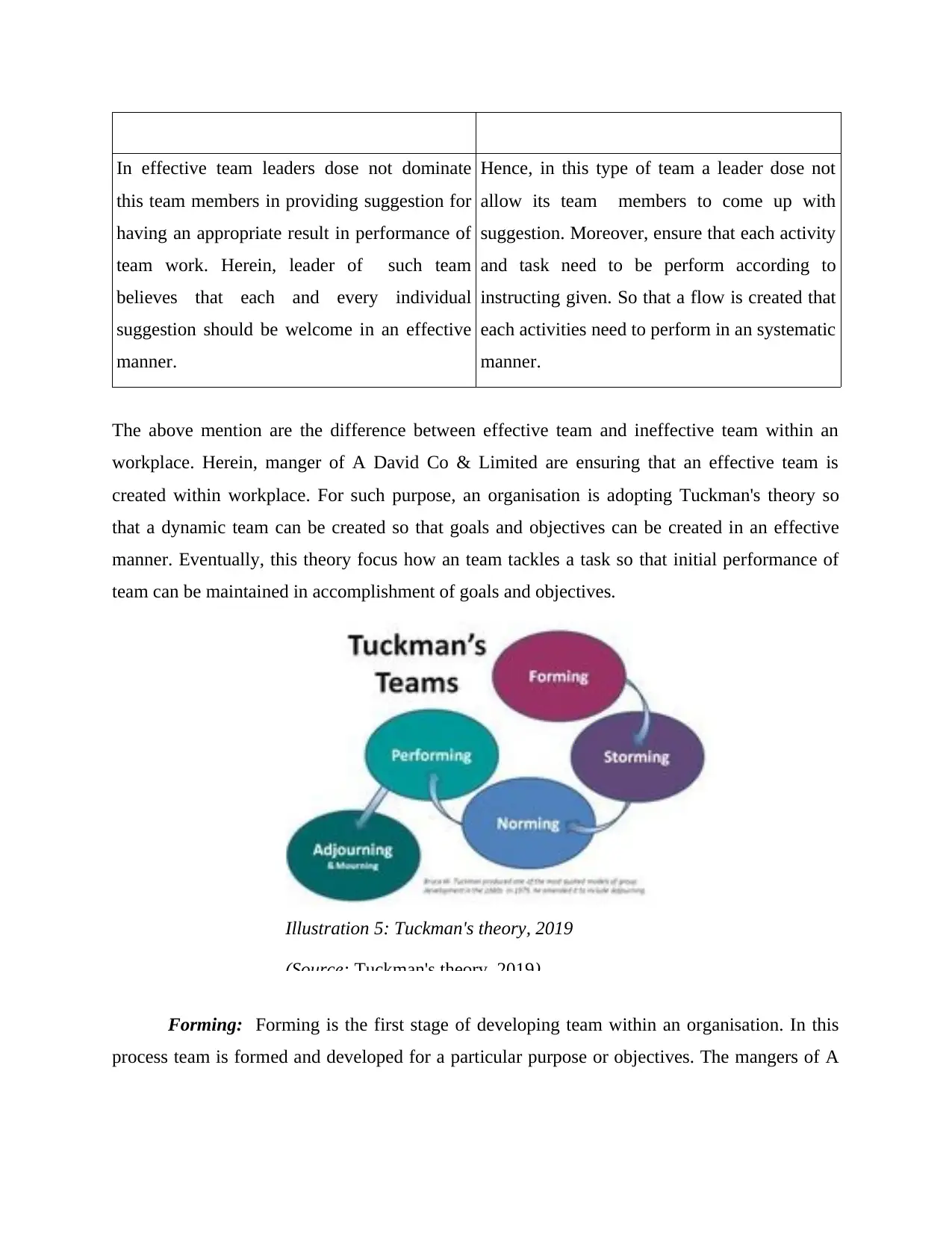
In effective team leaders dose not dominate
this team members in providing suggestion for
having an appropriate result in performance of
team work. Herein, leader of such team
believes that each and every individual
suggestion should be welcome in an effective
manner.
Hence, in this type of team a leader dose not
allow its team members to come up with
suggestion. Moreover, ensure that each activity
and task need to be perform according to
instructing given. So that a flow is created that
each activities need to perform in an systematic
manner.
The above mention are the difference between effective team and ineffective team within an
workplace. Herein, manger of A David Co & Limited are ensuring that an effective team is
created within workplace. For such purpose, an organisation is adopting Tuckman's theory so
that a dynamic team can be created so that goals and objectives can be created in an effective
manner. Eventually, this theory focus how an team tackles a task so that initial performance of
team can be maintained in accomplishment of goals and objectives.
Forming: Forming is the first stage of developing team within an organisation. In this
process team is formed and developed for a particular purpose or objectives. The mangers of A
Illustration 5: Tuckman's theory, 2019
(Source: Tuckman's theory, 2019)
this team members in providing suggestion for
having an appropriate result in performance of
team work. Herein, leader of such team
believes that each and every individual
suggestion should be welcome in an effective
manner.
Hence, in this type of team a leader dose not
allow its team members to come up with
suggestion. Moreover, ensure that each activity
and task need to be perform according to
instructing given. So that a flow is created that
each activities need to perform in an systematic
manner.
The above mention are the difference between effective team and ineffective team within an
workplace. Herein, manger of A David Co & Limited are ensuring that an effective team is
created within workplace. For such purpose, an organisation is adopting Tuckman's theory so
that a dynamic team can be created so that goals and objectives can be created in an effective
manner. Eventually, this theory focus how an team tackles a task so that initial performance of
team can be maintained in accomplishment of goals and objectives.
Forming: Forming is the first stage of developing team within an organisation. In this
process team is formed and developed for a particular purpose or objectives. The mangers of A
Illustration 5: Tuckman's theory, 2019
(Source: Tuckman's theory, 2019)
⊘ This is a preview!⊘
Do you want full access?
Subscribe today to unlock all pages.

Trusted by 1+ million students worldwide
1 out of 18
Related Documents
Your All-in-One AI-Powered Toolkit for Academic Success.
+13062052269
info@desklib.com
Available 24*7 on WhatsApp / Email
![[object Object]](/_next/static/media/star-bottom.7253800d.svg)
Unlock your academic potential
Copyright © 2020–2025 A2Z Services. All Rights Reserved. Developed and managed by ZUCOL.





